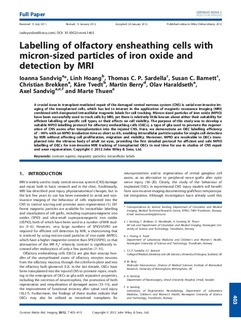Labelling of olfactory ensheathing cells with micron-sized particles of iron oxide and detection by MRI
Sandvig, Ioanna; Hoang, Linh; Sardella, Thomas CP; Barnett, SC; Brekken, Christian; Tvedt, Kåre; Berry, Martin; Haraldseth, Olav; Sandvig, Axel; Thuen, Marte
Journal article, Peer reviewed
Published version
Permanent lenke
http://hdl.handle.net/11250/2623054Utgivelsesdato
2012Metadata
Vis full innførselSamlinger
Sammendrag
A crucial issue in transplant‐mediated repair of the damaged central nervous system (CNS) is serial non‐invasive imaging of the transplanted cells, which has led to interest in the application of magnetic resonance imaging (MRI) combined with designated intracellular magnetic labels for cell tracking. Micron‐sized particles of iron oxide (MPIO) have been successfully used to track cells by MRI, yet there is relatively little known about either their suitability for efficient labelling of specific cell types, or their effects on cell viability. The purpose of this study was to develop a suitable MPIO labelling protocol for olfactory ensheathing cells (OECs), a type of glia used to promote the regeneration of CNS axons after transplantation into the injured CNS. Here, we demonstrate an OEC labelling efficiency of >90% with an MPIO incubation time as short as 6 h, enabling intracellular particle uptake for single‐cell detection by MRI without affecting cell proliferation, migration and viability. Moreover, MPIO are resolvable in OECs transplanted into the vitreous body of adult rat eyes, providing the first detailed protocol for efficient and safe MPIO labelling of OECs for non‐invasive MRI tracking of transplanted OECs in real time for use in studies of CNS repair and axon regeneration.
